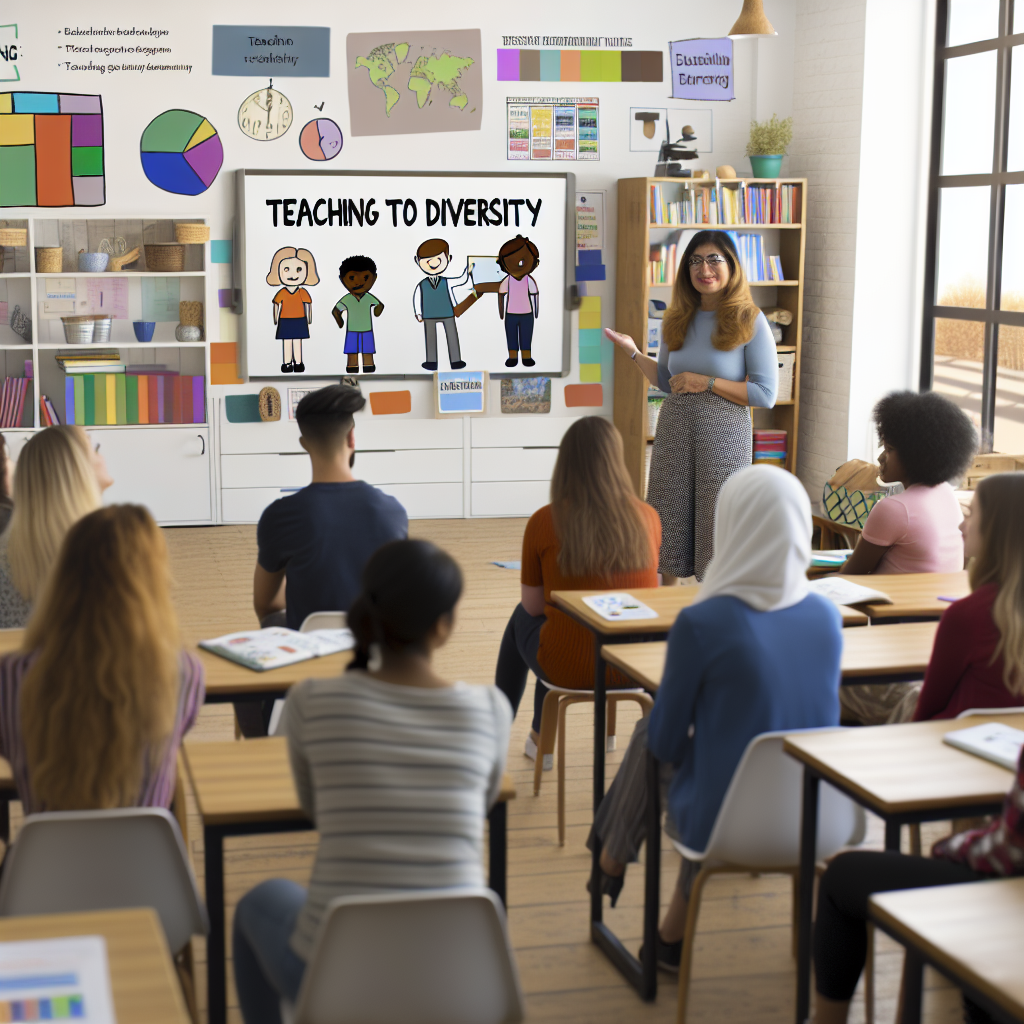
Teaching to Diversity: Proven Strategies for Inclusive Learning Environments
Introduction
In today’s diverse classrooms, the concept of Teaching to Diversity: Proven Strategies for Inclusive Learning Environments is more important than ever. Educators face the challenge of meeting the needs of students from various backgrounds, learning styles, and abilities. The rise of multicultural classrooms necessitates innovative approaches to ensure that every learner not only participates but thrives. From differentiated instruction to fostering a supportive community, the strategies employed can make a profound difference in the educational experience, promoting not just learning, but understanding and collaboration.
Understanding Diversity in Education
The Landscape of Diversity
Diversity in education encompasses a wide range of differences, including but not limited to socioeconomic status, race, ethnicity, language, ability, and learning styles. Recognizing this diversity is the first step in creating inclusive learning environments.
Table 1: Dimensions of Diversity in the Classroom
| Dimension | Description |
|---|---|
| Socioeconomic | Variation in family income, education, and opportunities |
| Racial & Ethnic | Different racial and ethnic backgrounds of students |
| Language | Students who are multilingual or learning English as a second language |
| Ability | Inclusion of students with disabilities or special needs |
| Learning Styles | Differences in how students process information |
Why Inclusion Matters
Inclusion isn’t just about physical presence; it’s about meaningful participation. Research shows that inclusive learning environments lead to:
- Improved academic achievement
- Enhanced social skills
- Greater empathy and respect among students
Case Study: The Melting Pot School
At "The Melting Pot School," a charter school in a diverse urban district, students speak over 15 different languages. The administration implemented a policy focused on collaborative learning to foster an inclusive atmosphere. By utilizing bilingual aides and culturally relevant materials, they increased student engagement by 35% in one academic year.
Analysis
The Melting Pot School case illustrates that acknowledging linguistic diversity and promoting collaborative learning can engage students from varied backgrounds effectively.
Proven Strategies for Inclusive Learning Environments
1. Differentiated Instruction
Teaching to Diversity: Proven Strategies for Inclusive Learning Environments begins with acknowledging that no two learners are alike. Differentiated instruction allows teachers to tailor their teaching styles to meet individual needs.
Flexible Grouping: Placing students in various ability groups can help cater to diverse learning needs.
- Tiered Assignments: Offering different levels of tasks ensures that all learners are challenged appropriately without overwhelming them.
Table 2: Differentiated Instruction Tactics
| Tactic | Description |
|---|---|
| Flexible Grouping | Students work in varied groups based on learning needs |
| Tiered Assignments | Tasks are differentiated by difficulty and support |
| Learning Contracts | Students negotiate their learning goals and paths |
2. Culturally Relevant Pedagogy
Culturally relevant pedagogy promotes the idea that students learn best when their culture and experiences are reflected in the curriculum. This might involve:
- Incorporating multicultural perspectives in literature.
- Using teaching materials that reflect diverse histories.
Case Study: The National Book Initiative
The National Book Initiative introduced a curriculum rich in diverse literature. Schools that adopted this initiative saw an increase in student reading comprehension scores, particularly among marginalized groups.
Analysis
This initiative highlights that curriculum appropriation can enhance the literary skills of students from various backgrounds, proving that inclusivity in teaching resources corresponds to improved academic performance.
3. Universal Design for Learning (UDL)
UDL is a framework that helps educators design courses that meet the needs of all learners by providing multiple means of engagement, representation, and action/expression.
Key Principles of UDL:
- Multiple Means of Engagement
- Multiple Means of Representation
- Multiple Means of Action and Expression
Table 3: UDL Strategies
| Principle | Strategy |
|---|---|
| Engagement | Offer choices in how students learn |
| Representation | Use visuals, audio, and text to present information |
| Action/Expression | Allow various ways for students to showcase their understanding |
4. Collaborative Learning
Fostering a collaborative learning environment encourages students to work together and learn from one another.
- Group projects allow students to share varied perspectives.
- Peer teaching can be an effective way for students to explain concepts to one another.
Case Study: Peer Mentorship Program
A peer mentorship program implemented in a high school allowed older students to mentor younger, struggling students. As a result, both groups reported a stronger sense of community and improved academic performance.
Analysis
This case shows that peer collaboration not only aids academic growth but also enhances social skills, as diverse groups learn to work together towards common goals.
Creating an Inclusive Classroom Culture
Building Relationships
Establishing strong relationships with students is crucial in creating inclusive environments. Teachers should:
- Spend time getting to know their students.
- Create a warm and welcoming atmosphere.
Encouraging Student Voice
Allowing students to express their thoughts and opinions fosters a sense of belonging and agency. Tools such as:
- Class discussions
- Anonymous feedback forms
can serve as platforms for students to share their views.
Celebrating Differences
Recognizing and celebrating diverse cultures and backgrounds within the classroom can help promote empathy and understanding.
- Host cultural days where students present on their backgrounds.
- Use thematic units that explore global cultures.
Overcoming Challenges
Common Barriers to Inclusion
Despite the best efforts, various challenges can hinder the implementation of inclusive practices. Some common barriers include:
- Lack of resources
- Insufficient teacher training
- Resistance from students or parents
Strategies to Address Challenges
- Professional Development: Ongoing training for educators on inclusive strategies is essential.
- Resource Allocation: Schools should invest in diverse materials and support services.
Conclusion
In summary, Teaching to Diversity: Proven Strategies for Inclusive Learning Environments is not a one-size-fits-all approach but rather a multi-faceted endeavor that requires dedication, creativity, and ongoing learning. By embracing differentiated instruction, culturally relevant pedagogy, UDL, and collaborative learning, educators can not only foster an inclusive classroom but also pave the way for a brighter, more equitable future in education.
Motivational Takeaway
Every educator has the power to transform their classroom into an inclusive space where all students can flourish. As we work towards this goal, let us remember that diversity is not a challenge to manage, but a strength to celebrate.
FAQs
1. How can I start incorporating inclusive strategies in my classroom?
Begin by conducting a needs assessment of your students and utilizing differentiated instruction strategies tailored to their unique learning styles.
2. What is the most crucial aspect of culturally relevant pedagogy?
The most crucial aspect is ensuring that your curriculum reflects the diverse cultures and backgrounds of your students, making it relatable and engaging.
3. How do I handle resistance from parents regarding inclusion?
Communicate the benefits of inclusion and involve parents in discussions about curriculum materials and strategies being implemented in the classroom.
4. What training resources are available for teachers?
Many organizations offer professional development sessions, webinars, and workshops focusing on inclusive education strategies and best practices.
5. How do collaborative learning initiatives benefit students?
They foster social skills, build teamwork, and allow for the exchange of diverse ideas and perspectives, enriching the learning experience.
6. Can technology support inclusive learning?
Absolutely! Assistive technology can help support students with disabilities, while online platforms can enhance collaborative projects between diverse learner groups.
By employing these strategies and maintaining a commitment to inclusivity, educators can truly embody the essence of teaching to diversity in their classrooms, ensuring that no student is left behind.
















